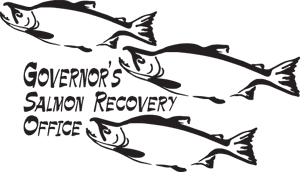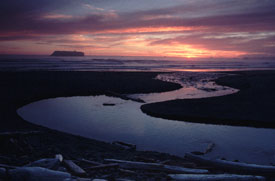

Scenes from Salmon Recovery Regions
Photos by Rollie Geppert

|
Scenes from Salmon Recovery Regions
|
| ABOUT US |
MONITORING |
DOCUMENTS AND PUBLICATIONS |
REGIONS |
SCIENCE AND ISP |
2004 State of Salmon in Watersheds now availableThe 2004 State of Salmon in Watersheds report looks at the current status of salmon recovery through maps, graphs, and short descriptions of what's happening in Washington's salmon recovery regions. In 1991, the federal government set off a warning bell by listing the first Pacific Northwest wild salmon as near extinction under the Endangered Species Act. By 1999, wild salmon had disappeared from about 40 percent of their historic breeding ranges in Washington, Oregon, Idaho, and California. In Washington, the numbers had dwindled so much that salmon were threatened or endangered in nearly three-fourths of the state. Governor Locke and the Legislature began a series of steps to reverse the trend, including:
"In every area of the state, we've gotten people together to talk about the future of our salmon, and we've backed those discussions with funding and resources to turn the people's vision into reality," Locke said. "Today, every watershed with salmon has at least one citizens' volunteer group working to restore and enhance habitats on which the fish depend. These groups have donated more than 145,000 hours each year and have been involved in more than 480 local projects." The 2004 report shows that we have made some significant progress in recovering listed salmon, but that we have much left to do. Governor Gary Locke Presents the First Regional Salmon Recovery Plan to Federal GovernmentGovernor Gary Locke, together with the Lower Columbia Fish Recovery Board and the Department of Fish and Wildlife, turned over the first locally developed regional salmon recovery plan completed in Washington to the federal government during an event December 15 in Vancouver. The event marked completion of the first recovery plan for salmon and steelhead in the state developed in partnership by local, state, federal, and tribal governments, community leaders and non-profit groups. At the event, Governor Locke; Dr. Jeffrey Koenings, director of the Department of Fish and Wildlife; and Bill Dygert, Acting Chair of the Lower Columbia Fish Recovery Board presented the salmon recovery plan created by the Board to the federal government. The plan is aimed at restoring five species of salmon as well as other fish to healthy, harvestable levels over the next 25 years. The plan encompasses areas on the lower Columbia River as well as 18 major and a number of lesser tributary basins in Clark, Cowlitz, Lewis, Skamania, and Wahkiakum, and portions of Pacific and Klickitat counties in Southwest Washington. There are 4 other regions in Washington preparing similar plans for the National Oceanic and Atmospheric Administration (NOAA-Fisheries) and the US Fish and Wildlife Service that are responsible for formal recovery plans under the Endangered Species Act. The Lower Columbia Fish Recovery Board's approach integrates several different planning efforts-including Endangered Species Act recovery planning, Northwest Power and Conservation Council sub-basin planning, and state salmon recovery and watershed planning-into a single regional plan. The plan's goals are to restore the region's salmon to healthy, harvestable levels. The plan also addresses other fish and wildlife that are important to the region, as well as providing a foundation for healthy watersheds for people. "From the outset, the Board has focused on preparing a recovery plan that works for both people and fish of the regionů a plan that will be implemented. It's not the Board's plan. It belongs to the agencies, local governments, tribes, scientists, organizations, fishermen, landowners, and citizens who joined with us to meld science and community values into a blueprint for recovery," said Jeff Breckel, Executive Director of the Lower Columbia Fish Recovery Board. "We are making progress and have seen a slowdown in the decline of our salmon populations, thanks to these many years of hard, innovative work, and with the help of improved ocean conditions," Locke said. "It is important that we recognize and celebrate our progress, but that we also not slow down. By continuing our commitment to this work, we can and will succeed in restoring our wild salmon populations so that they no longer need protection under the Endangered Species Act." In accepting the report, Bob Lohn, Regional Administrator for NOAA-Fisheries said, "Local involvement is absolutely vital to salmon recovery. Without locally led efforts, no recovery plan will succeed. We're committed to this plan as the foundation for salmon recovery. It's good for salmon and it's good for the region." If you have comments or questions regarding this Web site, please send us an E-mail. |
Updated December 16, 2004 |